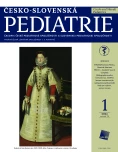Differential diagnosis of polyuria-polydipsia
Authors:
Votava Felix
Authors‘ workplace:
Klinika dětí a dorostu, 3. lékařská fakulta, Univerzita Karlova a FN Královské Vinohrady, Praha
Published in:
Čes-slov Pediat 2024; 79 (1): 33-38.
Category:
Chapters for Specialization in Pediatrics
doi:
https://doi.org/10.55095/CSPediatrie2024/006
Overview
In clinical practice, it is often difficult to distinguish psychogenic (or habitual) polydipsia from true organic polyuria.
First-line tests: urine chemistry, glycaemia: hyperglycaemia, glycosuria and ketonuria confirm diabetes mellitus. Kalemia and calcemia: chronic hypokalaemia or hypercalcaemia lead to loss of renal concentrating capacity. Plasma creatinine level and ultrasound imaging of the kidney: exclude renal impairment with possible loss of concentrating capacity. Serum and urine osmolality from samples as close in time as possible: incidental detection of high urine osmolality with normal serum osmolality is indicative of psychogenic polydipsia. Hyperosmolar serum and hypostenuric urine confirm diabetes insipidus (DI). The differential diagnosis needs to proceed further if the first line does not lead to a decision.
Second-line test: the fluid withdrawal test without desmopresin (DDAVP) administration. During the test are monitored diuresis, patient weight, urine osmolality of each portion during the test and the first portion of urine after its completion. The frequency of serum osmolality measurements during the test depends on the patient‘s condition and the diuresis being monitored. If diuresis decreases during the test and urine osmolality increases, we are probably approaching a diagnosis of psychogenic polydipsia and can reduce the frequency of serum osmolality testing. Persistent high diuresis of hypostenuric urine is suggestive of DI. In an infant with DI, even 3 hours of thirst can lead to hypernatremic dehydration! Terminate the test if one of the following conditions is met: 1. signs of dehydration; 2. uncontrollable thirst (ethical reason); 3. evidence of sufficient renal concentrating ability i.e. high urine osmolality. Usually we are satisfied with the finding of urine osmolality > 500 in infants and > 600 in toddlers and > 750 mOsm/kg in older children. If the condition for test termination is not met within 12 hours, patient non-cooperation is almost certain.
Third-line test: the fluid withdrawal test after DDAVP administration. It is used to differentiate between central and nephrogenic DI. The same test is used but after DDAVP administration. A decrease in diuresis and an increase in urine osmolality while maintaining serum osmolality is indicative of central DI.
Fourth-line examinations: in central DI, we perform CNS imaging by MR, assess other endocrine functions of the hypothalamic-pituitary axis, and add technetium skeletal scintigraphy to exclude osteolytic foci in Langerhans cell histiocytosis. A more precise diagnostic classification of nephrogenic DI is possible by molecular genetics.
Sources
1. Partsch CJ, Mönig H, Sippell WG. Endokrinologická funkční diagnostika. Praha: Galén 2008.
2. Lebl J, Zapletalová J, Koloušková S, et al. Dětská endokrinologie. Praha: Galén 2004.
3. Hochberg Z. Practical Algoritms in Pediatric Endocrinology. Karger 2017.
4. Kliegman RM, St.Geme III JW. Nelson Textbook of Pediatrics. 21st Edition. Elsevier 2019.
5. Christ-Crain M, Gaisl O. Diabetes insipidus. Presse Med 2021; 50. Dostupné na: http://creativecommons.org/licenses/by-nc-nd/4.0/
6. Pedrosa W, et al. A combined outpatient and inpatient overnight water deprivation test is effective and safe in diagnosing patients with polyuria-polydipsia syndrome. Endocr Pract 2018; 24(11): 963–972.
7. Vaz de Castro PAS, et al. Nephrogenic diabetes insipidus: a comprehensive overview. J Pediatr Endocrinol Metab 2022; 35(4): 421–434.
8. Vergier J, et al. Rapid differential diagnosis of diabetes insipidus in a 7-month-old infant: The copeptin approach. Arch Pediatr 2018; 25(1): 45–47.
Labels
Neonatology Paediatrics General practitioner for children and adolescentsArticle was published in
Czech-Slovak Pediatrics

2024 Issue 1
Most read in this issue
- Differential diagnosis of polyuria-polydipsia
- Abdominal solid organ injuries in children – identification, basic principles of clinical evaluation and management
- The prevention of infective endocarditis in childhood in the Czech Republic, a current approach
- Infantile feeding disorders
